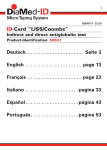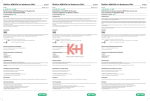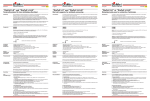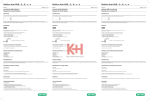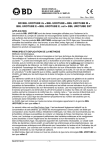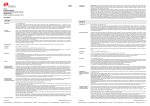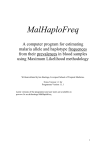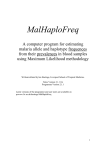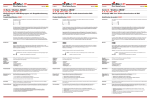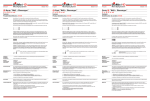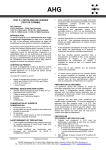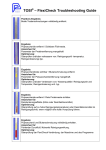Download ID-DiaClon Anti-D
Transcript
ID-DiaClon Anti-D Deutsch ID-DiaClon Anti-D B007531 02.13 Produkt-Identifikation: 09410 English ID-DiaClon Anti-D B007531 02.13 Français B007531 02.13 Product-Identification: 09410 Identification de produit : 09410 VERWENDUNGSZWECK intended use UTILISATION PRÉVUE Das ID-DiaClon Anti-D wird zur Bestätigung von RhD negativen Ergebnissen und zur komplementären Charakterisierung von D-Varianten (D weak und D partial) eingesetzt. The ID-DiaClon Anti-D is intended to be used for the confirmation of RhD negative results and complementary characterization of D variants (weak D and partial D). ID-DiaClon Anti-D sert à confirmer les résultats des tests sur le Rhésus (Rh) négatif et la caractérisation complémentaire des variants D (D faible et partiel). Einleitung Introduction Introduction Die zunehmende Anwendung von monoklonalen Anti-D’s aus verschiedenen Zelllinien kann bei der Interpretation der D-Antigen-Testung zu Problemen führen. Im Besonderen bei der Differenzierung von schwachem D und partiellen D (D Varianten). The increasing use of monoclonal anti-D’s from different cell lines can create problems in the interpretation of D antigen testing, in particular the differentiation of weak D and partial D (D variant). Le recours de plus en plus fréquent à des anticorps monoclonaux anti-D à partir de différentes lignées cellulaires peut créer des problèmes d’interprétation des tests sur l’antigène D, en particulier la différenciation des D faible et partiel (variants D). Im ID-Card System weist eine +++ bis ++++ Reaktion auf das Vorliegen des D-Antigens hin, eine schwächere Reaktion deutet auf ein schwaches D hin. Diese schwach positiven Reaktionen können in Abhängigkeit von der verwendeten monoklonalen Zelllinie variieren. In the ID-Card System, a +++ to ++++ reaction indicates the presence of the D antigen and weaker reactions indicate weak D. These weak positive reactions can vary depending on the monoclonal cell line used. Dans le système par carte-ID, une réaction +++ à ++++ indique la présence de l’antigène D et des réactions plus faibles, un D faible. Ces réactions positives faibles peuvent varier en fonction de la lignée cellulaire monoclonale utilisée. Erythrozyten, die im direkten Coombs Test eine negative Reaktion zeigen und im Indirekten Coombs Test positive reagieren, müssen als schwaches D oder partielles D (D Variante) betrachtet werden. Cells giving negative reactions in the direct test and positive by IAT are considered as weak D or partial D (D variant). Les cellules donnant des réactions négatives dans le cadre du test direct et positives par test indirect à l’antiglobuline (TIA ou test de Coombs indirect) sont considérées comme des antigènes D faible et partiel (variants D). Eine weiterführende Untersuchung kann im ID-System mit Hilfe eines monoklonalen Anti-D’s, das zur Charakterisierung von schwachen D und DVI hergestellt wurde, unter Verwendung der ID-Karte ˝Coombs Anti-IgG˝ oder ˝LISS/Coombs˝, durchgeführt werden. A supplementary verification can be performed in the ID-System with the aid of a monoclonal anti-D formulated to characterize weak D’s and DVI using the ID-Card ˝Coombs Anti-IgG˝ or the ID-Card ˝LISS/Coombs˝. On peut procéder à une vérification supplémentaire dans le système d’identification à l’aide d’un anticorps anti-D monoclonal formulé pour définir les D faibles et le DVI au moyen de la carte ID ˝Coombs Anti-IgG˝ ou ˝LISS/Coombs˝. Reagenzien Reagents Réactifs ˝ID-DiaClon Anti-D˝ enthält monoklonales Anti-D IgG (Zellinie ESD1), gebrauchsfertiges Reagenz in 5 ml Fläschchen. Konservierungsmittel: Die Antibiotika Trimetoprim und Sulfamethoxazole. ˝ID-DiaClon Anti-D˝ containing monoclonal anti-D IgG (cell line ESD1), supplied as a ready-to-use reagent in vials of 5 ml. Preservatives: trimethoprime and sulfamethoxazole. ˝ID-DiaClon Anti-D˝ contenant de l’anti-D monoclonal de nature IgG (lignée cellulaire ESD1), réactif prêt à l’emploi, en flacon de 5 ml. Conservateurs : les antibiotiques trimétoprime et sulfaméthoxazole. Achtung: Alle Reagenzien sollten als potentiell infektiös gehandhabt werden. Caution: All reagents should be treated as potentially infectious. Attention : Tout réactif doit être considéré comme potentiellement infectieux. Stabilität: siehe Verfallsdatum auf dem Etikett. Stability: see expiry date on label. Stabilité : voir la date de péremption sur l’étiquette. Zusätzlich benötigte Reagenzien Additional reagents required Réactifs supplémentaires nécessaires •ID-Karte ˝Coombs Anti-IgG˝ enthält 6 Mikroröhrchen mit Anti-IgG (Kaninchen), in der Gelmatrix. Konservierungsmittel: < 0,1% NaN3. • ID-Karte ˝LISS/Coombs˝ mit 6 Mikroröhrchen enthält polyspezifisches AHG (Kaninchen-Anti-IgG und monoklonales Anti-C3d, Zellinie C139-9) in der Gelmatrix. Konservierungsmittel: < 0,1% NaN3. •ID-Diluent 2: Modifiziertes LISS zur Herstellung der Erythrozytensuspensionen. •ID-Card ˝Coombs Anti-IgG˝ with 6 microtubes containing anti-IgG (rabbit), within the gel matrix. Preservative: < 0.1% NaN3. • ID-Card ˝LISS/Coombs˝ with 6 microtubes containing polyspecific AHG (rabbit anti-IgG and monoclonal anti-C3d, cell line C139-9) within the gel matrix. Preservative: < 0.1% NaN3. • ID-Diluent 2: modified LISS for red cell suspension. •Carte-ID ˝Coombs Anti-IgG˝ avec 6 microtubes contenant de l’antiglobuline humaine IgG (de lapin), incluse dans le gel. Conservateur : < 0,1% NaN3. • Carte-ID ˝LISS/Coombs˝ : avec 6 microtubes contenant de l’antiglobuline humaine polyspécifique (anti-IgG de lapin et anti-C3d monoclonal, lignée cellulaire C139-9) inclus dans le gel. Conservateur : < 0,1% NaN3. • ID-Diluent 2 : LISS modifié pour suspensions d’hématies. (siehe diesbezügliche Packungsbeilage) (see related package insert) (voir mode d’emploi correspondant) Weitere erforderliche Materialien Further materials required Matériaux supplémentaires nécessaires • • • • • • • • • • • • • • • • • • • • • ID-Dispenser ID-Pipetor ID-Tips (Pipetor-Spitzen) ID-Arbeitsplatz Suspensionsröhrchen ID-Inkubator 37 °C ID-Zentrifuge 6, 12 oder 24 ID-Dispenser ID-Pipetor ID-Tips (pipetor tips) ID-Working Table Suspension Tubes ID-Incubator 37 °C ID-Centrifuge 6, 12 or 24 ID-Dispenser ID-Pipetor ID-Tips (cônes pour pipette) Tubes pour suspensions ID-Table de travail ID-Incubateur à 37 °C ID-Centrifuge 6, 12 ou 24 Probenmaterial Sample material Échantillons Für verlässliche Resultate sollte die Bestimmung mit frisch abgenommenen Proben durchgeführt werden oder in Übereinstimmung mit lokalen Laborvorschriften für die Akzeptanz von Probenmaterial erfolgen. Vorzugsweise sollte die Probengewinnung in den Antikoagulantien Citrat, EDTA oder CPD-A erfolgen. Native Proben (kein Antikoagulanz) können auch verwendet werden. For optimal results, the determination should be performed using a freshly drawn sample, or in accordance with local laboratory procedures for sample acceptance criteria. Preferably, blood samples should be drawn into citrate, EDTA or CPD-A anticoagulant. Samples drawn into plain tubes (no anticoagulant) may also be used. Afin d’obtenir des résultats fiables, la détermination devrait se faire sur du matériel fraîchement prélevé ou conforme aux exigences du laboratoire auquel la demande d’analyses est adressée. L’échantillon devrait être prélevé de préférence sur anticoagulant citrate, EDTA ou CPD-A. Du sang prélevé sans anticoagulant (natif) peut également être utilisé. Vorbereitung der Blutprobe Preparation of blood sample Préparation de l’échantillon de sang Eine 0,8%ige Erythrozytensuspension in ID-Diluent 2 wie folgt herstellen: Diluent vor Gebrauch auf Raumtemperatur bringen. Prepare a 0.8% red cell suspension in ID-Diluent 2 as follows: Allow the diluent to reach room temperature before use. Préparer une suspension d’hématies à 0,8% en ID-Diluent 2, comme suit : Ramener le diluant à température ambiante avant utilisation. 1. 1,0 ml ID-Diluent 2 in ein sauberes Röhrchen pipettieren. 2. 10 µl Erythrozytenkonzentrat hinzugeben; leicht mischen. 1. Dispense 1.0 ml of ID-Diluent 2 into a clean tube. 2. Add 10 µl of packed red cells, mix gently. 1. Distribuer 1,0 ml d’ID-Diluent 2 dans un tube propre. 2. Ajouter 10 µl de culot d’hématies, mélanger doucement. Die Erythrozytensuspension kann sofort verwendet werden. The cell suspension may be used immediately. La suspension d’hématies peut être utilisée immédiatement. kontrollen controls contrôles Bekannte schwach D positive und -negative Erythrozyten sollten zur Überprüfung der Testgültigkeit parallel mitgeführt werden. Falsch positive Reaktionen können durch positiven direkten Antiglobulintest (DAT) erfolgen. Positive Ergebnisse im D-Bestätigungstest können nur bei negativem DAT auf der ID-Karte ˝Coombs Anti-IgG˝ oder der ID-Karte ˝LISS/Coombs˝ validiert werden. Known weak D positive and negative samples should be included to validate the results. As false positive results may occur in cases where the direct anti-globulin test (DAT) is positive, all positives should be confirmed negative in the DAT using the ID-Card ˝Coombs Anti-IgG˝ or the ID-Card ˝LISS/Coombs˝. Des échantillons D faible positifs et négatifs connus devront être inclus pour valider les résultats. Comme il est possible d’obtenir des résultats faussement positifs dans le cas où le test direct d’antiglobuline (TDA) est positif, tous les résultats positifs devraient être confirmés par un TDA négatif en utilisant la carte-ID ˝Coombs Anti-IgG˝ ou la carte-ID ˝LISS/Coombs˝. TestduRchführung Test procedure Méthode Keine ID-Karten benutzen mit Anzeichen von Austrocknung, Luftblasen, beschädigter Versiegelung oder Tropfen des Gels bzw. des Überstandes im oberen Teil der Mikrokammer oder auf der Unterseite der Versiegelung. Do not use ID-Cards which show signs of drying, have bubbles, damaged seals, drops of gel or supernatant in the upper part of the microtubes or on the underside of the aluminium foil. Ne pas utiliser les cartes-ID présentant des signes de desséchement, des bulles d’air dans le gel, un système de fermeture endommagé, des goutelettes de gel ou de surnageant sur les parois supérieures des microtubes ou sur la face interne de la languette d’aluminium. Reagenzien vor Gebrauch auf Raumtemperatur (18–25 °C) bringen. Allow the reagents to reach room temperature (18–25 °C) before use. Ramener les réactifs à température ambiante (18–25 °C) avant utilisation. 1.Die ID-Karte mit den Daten des Spenders /Neugeborenen beschriften. 2. Aluminiumfolie von den benötigten Mikroröhrchen in aufrechter Kartenposition entfernen. 3.50 µl der Erythrozytensuspension in das entsprechende Mikroröhrchen pipettieren. 4.50 µl ˝ID-DiaClon Anti-D˝ für Bestätigung von schwachem D mit IAT in das Mikroröhrchen dazugeben. 5.ID-Karte im ID-Inkubator während 15 Minuten bei 37 °C inkubieren. 6.ID-Karte 10 Minuten in der ID-Zentrifuge zentrifugieren. 7.Reaktionen ablesen und aufzeichnen. 1.Identify ID-Card with donor’s/neonate’s number/details as appropriate (see remarks). 2.Remove the aluminium foil from as many microtubes as required by holding the ID-Card in the upright position. 3.Add 50 µl of the red cell suspension to the appropriate microtube. 4.Add 50 µl of the ˝ID-DiaClon Anti-D˝ for confirmation of weak D by IAT to the microtube. 5.Incubate the ID-Card 15 minutes at 37 °C in the ID-Incubator. 6.Centrifuge the ID-Card for 10 minutes in the ID-Centrifuge. 7.Read and record the result. 1.Identifier la carte-ID avec le numéro d’identification du donneur/du nouveau-né/toute identification complémentaire appropriée (voir remarques). 2.Décoller la languette d’aluminium des microtubes nécessaires en tenant la carte-ID en position verticale. 3.Distribuer 50 µl de la suspension d’hématies dans le microtube. 4.Ajouter 50 µl du réactif ˝ID-DiaClon Anti-D˝ pour confirmation de D faible par TIA au microtube. 5.Incuber la carte-ID 15 minutes à 37 °C dans l’ID-Incubateur. 6.Centrifuger la carte-ID 10 minutes dans l’ID-Centrifuge. 7.Lire et noter les réactions. ID-DiaClon Anti-D ID-DiaClon Anti-D ID-DiaClon Anti-D Français B007531 02.13 English B007531 02.13 Deutsch B007531 02.13 Interprétation des résultats Interpretation of the results Interpretation der Ergebnisse A)Principe A)Principle A)Prinzip Positif :Hématies agglutinées formant une ligne rouge à la surface du gel ou des agglutinats dispersés dans le gel. Positive:Agglutinated cells forming a red line on the surface of the gel or agglutinates dispersed in the gel. Positiv:Agglutinierte Erythrozyten bilden eine rote Linie auf dem Gel oder sind im Gel verteilt. Négatif : Negative:Compact button of cells on the bottom of the microtube. Negativ: Hématies en culot compact au fond du microtube. B)Réactions de RhD en utilisant ˝ ID-DiaClon Anti-D˝ B)Reactions of RhD using ˝ ID-DiaClon Anti-D˝ Kompaktes Erythrozytensediment am Boden des Mikroröhrchens. B)Reaktionen von RhD unter Verwendung von ˝ ID-DiaClon Anti-D˝ RhD positif RhD faible/DVI * RhD négatif RhD positive Rh weak D/DVI * RhD negative RhD positiv Rh schwach D/DVI * RhD negativ ++++ + à +++ - ++++ + to +++ - ++++ + bis +++ - *A fin de distinguer les variants (D faible et partiel), il est conseillé d’approfondir l’analyse de l’échantillon avec l’ID-Partial RhD Typing Set (RÉF. 001451) ou l’Extended Partial RhD Typing Set (REF 001461) (cf. notices des boîtes correspondantes). Différenciation de RhD et RhD faible : Test direct sur carte-ID avec anti-D réactions réactions Differentiation between RhD and Rh weak D: +++ à ++++ ++ à neg. Direct test using an ID-Card with anti-D Test avec ˝ID-DiaClon Anti-D˝ et la carte-ID ˝Coombs Anti-IgG˝ ou la carte-ID ˝LISS/Coombs˝. Résultats * In order to distinguish between variants (weak D and partial-D), it is advised to further investigate the sample using the ID-Partial RhD Typing Set (REF 001451) or Extended Partial RhD Typing Set (REF 001461) (see related package inserts). ++++ +++ à + RhD positif RhD faible/DVI Test with ˝ID-DiaClon Anti-D˝ and the ID-Card ˝Coombs Anti-IgG˝ or the ID-Card ˝LISS/Coombs˝. Results *U m zwischen den Varianten (D weak und D partial) unterscheiden zu können, wird eine weitere Untersuchung der Probe mit dem ID-Partial RhD Typing Set (REF 001451) oder Extended Partial RhD Typing set (REF 001461) empfohlen (siehe entsprechende Packungsbeilagen). reactions reactions Differenzierung zwischen RhD und Rh schwaches D: +++ to ++++ ++ to neg. Direkter Test mit einer ID-Karte mit Anti-D ++++ +++ to + RhD positive Rh weak D/DVI Test mit ˝ID-DiaClon Anti-D˝ und der ID-Karte ˝Coombs Anti-IgG˝ oder der ID-Karte ˝LISS/Coombs˝. Ergebnisse Reaktionen Reaktionen +++ bis ++++ ++ bis neg. ++++ +++ bis + RhD positiv Rh schwaches D/DVI Remarques remarks anmerkungen L’anti-D contenu dans cette carte a été sélectionné pour réagir avec les phénotypes DVI. The anti-D contained in this vial has been selected to react with the DVI phenotype. Das in dieser Karte befindliche Anti-D wurde ausgewählt, um mit dem DVI Phenotyp zu reagieren. Limites Limitations einschränkungen a)Les cartes-ID présentant des bulles d’air dans le gel ou des goutelettes dans la partie supérieure des microtubes ou sur la languette métallique doivent être centrifugées avant utilisation. b)Des contaminations, bactériennes ou autres, du matériel utilisé peuvent provoquer des résultats faussement positifs ou faussement négatifs. c)Des résidus de fibrine dans la suspension d’hématies peuvent emprisonner quelques cellules non agglutinées, formant ainsi une fine ligne rose à la surface du gel, alors que la plupart des hématies sont dans le fond du microtube après centrifugation. d)L’observation stricte des méthodes et l’emploi de l’équipement recommandé sont essentiels. L’équipement doit être régulièrement contrôlé selon les procédures des BPL. e)L’utilisation de diluants autres que l’ID-Diluent 2 peut modifier les résultats. f)Des suspensions d’hématies trop concentrées ou trop diluées peuvent provoquer des résultats aberrants. a)ID-Cards which show air bubbles or gel drops in the upper part of the microtubes and/or the seal, must be centrifuged before use. b)Bacterial or other contamination of materials used can cause false positive or false negative results. c)Fibrin residues in the red cell suspension may trap non-agglutinated cells presenting a fine pink line on top of the gel while most of the cells are on the bottom of the microtube after centrifugation. d)Strict adherence to the procedures and recommended equipment is essential. The equipment should be checked regularly according to GLP procedures. e)Use of suspension solutions other than ID-Diluent 2 may modify the reactions. f)Too heavy or too weak red cell suspensions can cause aberrant results. a)ID-Karten mit Luftblasen oder Gel im oberen Bereich der Mikrokammern und/oder Versiegelung müssen vor Gebrauch zentrifugiert werden. b)Bakterielle oder andere Kontaminationen des verwendeten Materials können falsch positive oder falsch negative Ergebnisse verursachen. c)Fibrinreste in der Erythrozytensuspension können nicht-agglutinierte Erythrozyten verkleben, die sich als feine rosa Linie auf der Geloberfläche darstellen, während die meisten Erythrozyten nach Zentrifugation am Boden der Mikroröhrchen ein kompaktes Sediment bilden. d)Striktes Befolgen der Anleitungen und Verwendung des erforderlichen Arbeitsmaterials sind unerlässlich. Das Arbeitsmaterial sollte regelmässig entsprechend der GLP-Richtlinien überprüft weden.dd e)Der Gebrauch anderer Lösungen als ID-Diluent 2 für die Erythrozytensuspensionen kann die Reaktionen beeinflussen. f)Zu starke oder zu schwache Erythrozytensuspensionen können abnormale Reaktionen hervorrufen. CARACTÉRISTIQUES DE PERFORMANCE Performance characteristics LEISTUNGSMERKMALE Les performances d’ID-DiaClon Anti-D ont été évaluées dans le cadre d’études internes réalisées à partir d’un groupe d’échantillons de variants. Ce réactif a permis de détecter les D faibles de type 1, 2, 3, 4.0, 4.1, 5, 6, 7, 8, 9,10, 11, 15 et 17. La lignée cellulaire contenue dans ID-DiaClon anti-D s’avère également détecter les variants suivants : DII/DNU, DIII, DV (évaluation de DVa uniquement), DCS, DVI, DVII, DOL, DFR, DAR et DAR-E, DKH/DAU-4 mais pas les suivants : DIV, DBT et DHAR (3). Performances of ID-DiaClon Anti-D have been evaluated during internal studies against a panel of variant samples. This reagent was able to detect weak D's Type 1, 2, 3, 4.0, 4.1, 5, 6, 7, 8, 9 ,10 11, 15, 17. The cell line included in the ID-DiaClon anti-D is also known to detect the following variants; DII/DNU, DIII, DV (only DVa evaluated), DCS, DVI, DVII, DOL, DFR, DAR and DAR-E, DKH/DAU-4 but not the following ones : DIV, DBT and DHAR (3). Die Eigenschaften des ID-DiaClons Anti-D wurde in internen Studien mit einem Panel verschiedener Proben evaluiert. Dieses Reagenz ist in der Lage D weak’s vom Typ 1, 2, 3, 4.0, 4.1, 5, 6, 7, 8, 9 ,10 11, 15, 17 zu detektieren. Von der im ID-DiaClon Anti-D enthaltene Zelllinie ist auch bekannt, dass sie die folgenden Varianten erkennt: DII/DNU, DIII, DV (nur DVa evaluiert), DCS, DVI, DVII, DOL, DFR, DAR und DAR-E, DKH/DAU-4. Nicht erkannt werden: DIV, DBT und DHAR (3). Bibliographie Bibliography Literatur 1.Mollison P. L., Engelfriet C. P. and Contreras M.: Blood Transfusion in Clinical Medicine. 10th ed. 1997; Blackwell Scientific Publications, Oxford. 2.Lapierre Y., Rigal D., Adam J. et al.: The gel test; A new way to detect red cell antigen-antibody reactions. Transfusion 1990; 30: 109–113. 3. Robb JS an Allan JC. (2005). Evaluation of a New Kit for the Identification of partial RhD Types by Heamagglutination. Transfusion Medicine, 15, Supplement 1: p51. 1.Mollison P. L., Engelfriet C. P. and Contreras M.: Blood Transfusion in Clinical Medicine. 10th ed. 1997; Blackwell Scientific Publications, Oxford. 2.Lapierre Y., Rigal D., Adam J. et al.: The gel test; A new way to detect red cell antigen-antibody reactions. Transfusion 1990; 30: 109–113. 3. Robb JS an Allan JC. (2005). Evaluation of a New Kit for the Identification of partial RhD Types by Heamagglutination. Transfusion Medicine, 15, Supplement 1: p51. 1.Mollison P. L., Engelfriet C. P. and Contreras M.: Blood Transfusion in Clinical Medicine. 10th ed. 1997; Blackwell Scientific Publications, Oxford. 2.Lapierre Y., Rigal D., Adam J. et al.: The gel test; A new way to detect red cell antigen-antibody reactions. Transfusion 1990; 30: 109–113. 3. Robb JS an Allan JC. (2005). Evaluation of a New Kit for the Identification of partial RhD Types by Heamagglutination. Transfusion Medicine, 15, Supplement 1: p51. Produits Products Produkte ID-DiaClon Anti-D 1 x 5 ml . . . . . . . . . . . . . . REF 007531 ID-DiaClon Anti-D 1 x 5 ml . . . . . . . . . . . . . . REF 007531 ID-DiaClon Anti-D 1 x 5 ml . . . . . . . . . . . . . . REF 007531 Ces produits sont garantis quant à leurs propriétés et qualités stipulées sur l’étiquette et dans le mode opératoire. Le fabricant décline toute responsabilité pour les cas où ces produits seraient employés ou vendus à d’autres usages. These products are guaranteed to perform as described on the label and in the instruction sheet. The manufacturer declines all responsibility arising out of the use or sale of these products in any way or for any purpose other than those described therein. Für diese Produkte wird nur Garantie übernommen, wenn sie gemäss den Angaben auf dem Etikett und der Anwendungsvorschrift verwendet werden. Jegliche Verantwortung wird ausdrücklich abgelehnt, wenn das Präparat für andere Zwecke gebraucht oder verkauft wird. Les modifications apportées à la version 06.12 sont colorées en gris. Changes to the version 06.12 are shaded gray. Änderungen zu der Version 06.12 sind grau gekennzeichnet. DiaMed GmbH Pra Rond 23 1785 Cressier FR Suisse DiaMed GmbH Pra Rond 23 1785 Cressier FR Switzerland DiaMed GmbH Pra Rond 23 1785 Cressier FR Schweiz ID-DiaClon Anti-D Italiano ID-DiaClon Anti-D B007531 02.13 Español ID-DiaClon Anti-D B007531 02.13 Português B007531 02.13 Identificazione prodotto: 09410 Identificación del producto: 09410 SCOPO UTILIDAD USO PREVISTO ID-DiaClon Anti-D ha lo scopo di confermare i risultati Rh negativi e la caratterizzazione complementare dei D variantI (D debole e D parziale). El ID-DiaClon Anti-D se utiliza para confirmar los resultados RhD negativos y para la caracterización complementaria de las variantes D (D débil y D parcial). O ID-DiaClon Anti-D está previsto ser usado para a confirmação de resultados RhD negativos e complementar caracterização de variantes D (D fraco e D parcial). Introduzione INTRODUCCIÓN Introdução Il crescente uso di anti-D monoclonali di differenti linee cellulari può causare problemi nell'interpretazione dei test di tipizzazione dell'antigene D, in particolare nella discriminazione tra D debole e D parziale (D variante). El uso creciente de anti D monoclonales procedentes de distintas líneas celulares puede crear problemas de interpretación en el estudio del antígeno D, particularmente en la diferenciación entre D débil y D parcial. O uso crescente de anti-D’s monoclonais de diferentes clones pode criar problemas na interpretação do teste de antigénio D, particularmente na diferenciação de D fraco e D parcial (variante D). Nel Sistema ID-Card, una reazione da 3+ a 4+ indica la presenza di un antigene D, mentre reazioni più deboli indicano la presenza di un D debole. Queste reazioni positive deboli possono variare in funzione della linea cellulare utilizzata. En el sistema ID-Card, una reacción entre +++ y ++++ indica la presencia de un antígeno D y reacciones de menor intensidad indican la presencia de un antígeno D débil. Estas reacciones débilmente positivas pueden variar dependiendo de la línea celular monoclonal utilizada. No Sistema ID-Card System, uma reação +++ a ++++ indica a presença do antigénio D e reações mais fracas indicam D fraco. Estas reações positivas fracas podem variar conforme o clone do anticorpo monoclonal usado. Le emazie che danno risultati negativi nella tipizzazione diretta e risultati positivi nel test indiretto all'antiglobulina, devono essere considerate come D deboli o D parziali (D varianti). Las células que dan reacciones negativas en la prueba directa y positivas en la PAI son consideradas como D débiles o parciales (Variantes de D). As células que apresentam reações negativas no teste directo e positivas no TAI são consideradas D fraco ou D parcial (variante D). Se puede realizar una verificación adicional en el Sistema ID con la ayuda de un anti-D monoclonal formulado para identificar antígenos D débiles y variantes DVI empleando para ello la ID-Card ˝Coombs Anti-IgG˝ or the ID-Card ˝LISS/Coombs˝. Pode ser executada uma verificação suplementar no ID-System com a ajuda de um anti-D monoclonal formulado para caracterizar D’s fracos e DVI usando o ID-Card ˝Coombs Anti-IgG˝ ou o ID-Card ˝LISS/Coombs˝. Reagenti Reactivos Reagentes ˝ID-DiaClon Anti-D˝ contenente anti-D monoclonale di classe IgG (linea cellulare ESD1), reagente pronto all’uso in flaconi da 5 ml. Conservanti: trimetoprim e sulfametoxazolo. ˝ID-DiaClon Anti-D˝ con IgG anti-D monoclonal (línea celular ESD1), suministrado como reactivo listo para su uso en frascos de 5 ml. Conservantes: trimetoprim y sulfametoxazol. ˝ID-DiaClon Anti-D˝ contendo anti-D IgG monoclonal (clone ESD1), reagente pronto a utilizar, em frascos 5 ml. Conservantes: trimetoprim e sulfametoxazol. Attenzione: Tutti i reagenti devono essere considerati potenzialmente infettivi. Precaución: Todos los reactivos deben tratarse como potencialmente infecciosos. Atenção: Todos os reagentes devem ser tratados como potencialmente infecciosos. Stabilità: vedere la data di scadenza sull’etichetta. Estabilidad: véase fecha de caducidad en la etiqueta. Estabilidade: ver prazo de validade no rótulo. Altri reagenti occorrenti Reactivos adicionales necesarios Reagentes adicionais necessários •Scheda-ID ˝Coombs Anti-IgG˝ con 6 microprovette contenenti anti-IgG (coniglio), nella matrice del gel. Conservante: < 0,1% NaN3. • Scheda-ID ˝LISS/Coombs˝ con 6 microprovette contenenti AHG polispecifico (anti-IgG di coniglio e anti-C3d monoclonale, linea cellulare C139-9) nella matrice del gel. Conservante: < 0,1% NaN3. •ID-Diluent 2: LISS modificato per la preparazione di sospensioni di emazie. •Tarjeta ID-Card ˝Coombs Anti-IgG˝ con 6 microtubos que contienen anti-IgG (de conejo) en el interior de la matriz de gel. Conservante: < 0,1% NaN3. • Tarjeta ID-Card ˝LISS/Coombs˝ con 6 microtubos que contienen AGH poliespecífica (anti-IgG de conejo y anti-C3d monoclonal, línea celular C139-9) en la matriz de gel. Conservante: < 0,1% NaN3. •ID-Diluent 2: LISS modificada para suspensiones de eritrocitos •Card-ID ˝Coombs Anti-IgG˝ com 6 microtubos contendo anti-IgG (coelho) em suspensão no gel. Conservante: < 0,1% NaN3. • Card-ID ̋LISS/Coombs˝ com 6 microtubos contendo AGH poli-específica (anti-IgG de coelho e anti-C3d monoclonal, clone C139-9) incluída no gel. Conservante: < 0,1% NaN3. •ID-Diluent 2: LISS modificado para suspensão de eritrócitos. (consultare la relativa scheda tecnica) (véase el prospecto correspondiente) (ver folheto informativo correspondente) Altri materiali occorrenti Otros materiales necesarios Outros materiais necessários • • • • • • • • • • • • • • • • • • • • • Un'ulteriore verifica può essere eseguita nel Sistema-ID utilizzando un Anti-D monoclonale formulato per evidenziare D deboli e DVI con le ID-Cards "Coombs Anti-IgG" o "LISS/Coombs". Dispensatore-ID Pipettatore-ID Puntali-ID (puntali per pipettatore) Stazione di lavoro-ID Provette per sospensione Incubatore-ID 37°C Centrifuga-ID 6, 12 o 24 ID-Dispenser ID-Pipetor ID-Tips (puntas para pipeta) ID-Working table (superficie de trabajo) Tubos de suspensión ID-Incubator 37 °C ID-Centrifuge (centrífuga) 6, 12 ó 24 Identificação do Produto: 09410 ID-Dispenser ID-Pipetor ID-Tips (pontas para pipetador) ID-Working Table Tubos de suspensão ID-Incubator 37 °C ID-Centrifuge 6, 12 ou 24 Campioni Muestras Amostras Per ottenere risultati attendibili, si consiglia di eseguire la determinazione su un campione fresco o conforme alle procedure del laboratorio per i criteri di accettazione dei campioni. I campioni devono essere prelevati preferibilmente in citrato, EDTA o CPD-A. Si possono comunque usare anche campioni prelevati in provette normali (senza anticoagulante). Para un resultado óptimo, la determinación debe realizarse con una muestra recién extraída, o cumpliendo la normativa local del laboratorio en cuanto a criterios de aceptabilidad de las muestras. Preferiblemente, las muestras de sangre deben recogerse utilizando citrato, EDTA o CPD-A como anticoagulante. También es posible utilizar muestras recogidas en tubos sin anticoagulante. Para obtenção dos resultados ideais, a determinação deve ser realizada numa amostra recentemente colhida, ou em conformidade com os critérios de aceitação do procedimento laboratorial local. As amostras de sangue devem, de preferência, ser colhidas em anticoagulante citrato, EDTA ou CPD-A. Também é possível utilizar amostras colhidas em tubos limpos (sem anticoagulante). Preparazione del campione Preparación de la muestra de sangre Preparação da amostra de sangue Preparare una sospensione di emazie allo 0,8% in ID-Diluent 2 nel modo seguente: Prima dell'uso portare il diluente a temperatura ambiente. Prepare una suspensión de eritrocitos al 0,8% en ID-Diluent 2 del modo siguiente: Deje que el diluyente alcance la temperatura ambiente antes de utilizarlo. Prepare uma suspensão de eritrócitos a 0,8% em ID-Diluent 2 do seguinte modo: Antes de utilizar, deixe o diluente atingir a temperatura ambiente. 1. Pipettare 1,0 ml di ID-Diluent 2 in una provetta pulita. 2. Aggiungere 10 μl di concentrato di emazie e mescolare delicatamente. 1. Pipetee 1,0 ml de ID-Diluent 2 en un tubo limpio. 2. Añada 10 μl de eritrocitos concentrados y agite suavemente. 1. Dispense 1,0 ml de ID-Diluent 2 num tubo limpo de vidro. 2. Adicione 10 μl de concentrado de eritrócitos, misture suavemente. La sospensione può essere utilizzata immediatamente. La suspensión de eritrocitos puede utilizarse inmediatamente. A suspensão de eritrócitos pode ser utilizada de imediato. controlli controles controlos Per convalidare i risultati si devono includere campioni di emazie D debole positive e negative note. Data la possibilità di ottenere reazioni falsamente positive in caso di test diretto all’antiglobulina (DAT) positivo, tutte le reazioni positive devono essere confermate mediante un DAT negativo con la scheda-ID ˝Coombs Anti-IgG˝ o la scheda-ID ˝LISS/Coombs˝. Para la validación de los resultados deben incluirse muestras D débil positivas y negativas conocidas. Dado que pueden producirse falsos positivos en los casos en que la prueba de antiglobulina directa (PAD) es positiva, debe confirmarse que todos los positivos dan negativo en la PAD empleando la tarjeta ID-Card ˝Coombs Anti-IgG˝ o la tarjeta ID-Card ˝LISS/Coombs˝. Para validar os resultados, devem ser incluídas amostras D fraco positivas e negativas conhecidas. Tendo em conta que podem ocorrer resultados falsamente positivos nos casos em que o teste da antiglobulina directo (TAD) é positivo, todos os resultados positivos devem ser confirmados por um TAD negativo, utilizando o Card-ID ˝Coombs Anti-IgG˝ ou o Card-ID ˝LISS/Coombs˝. Procedura Procedimiento de la prueba Procedimento do teste Non utilizzare ID-Cards che mostrano segni di disidratazione, bolle, pellicole danneggiate, gocce di gel o surnatante nella parte superiore delle microprovette o sotto la copertura di alluminio. No usar las tarjetas ID-Card que muestren signos de desecación, burbujas en el gel, sellado defectuoso, gotas de gel o de sobrenadante en la parte superior de los microtubos o en la superficie interior del aluminio de sellado. Não usar Cards-ID que tenham sinais de secagem, bolhas, selos danificados, gotas de gel ou sobrenadante na parte superior dos microtubos ou na parte de baixo da película de alumínio. Prima dell‘uso portare i reagenti a temperatura ambiente (18–25 °C). Deje que los reactivos alcance la temperatura ambiente (18–25 °C) antes de utilizarlo. Antes de utilizar, deixe os reagentes atingir a temperatura ambiente (18–25 °C). 1.Contrassegnare opportunamente la scheda-ID con l’identificativo del donatore/neonato/altri riferimenti (vedere note). 2.Rimuovere la copertura di alluminio dalle microprovette da utilizzare, tenendo la scheda-ID in posizione verticale. 3.Aggiungere 50 µl di sospensione di emazie nella corrispondente microprovetta. 4.Aggiungere nella provetta 50 µl di ˝ID-DiaClon Anti-D˝ per la conferma di D debole mediante IAT. 5.Incubare la scheda-ID per 15 minuti a 37 °C nell’incubatore-ID. 6.Centrifugare la scheda-ID per 10 minuti nella centrifuga-ID. 7.Leggere e trascrivere le reazioni. 1.Identificar la tarjeta ID-Card con el nombre o número de identificación del donante o del recién nacido (ver observaciones). 2.Retirar la lámina de sellado sólo de los microtubo que se vayan a utilizar manteniendo la tarjeta ID-Card en posición vertical. 3.Añada 50 µl de la suspensión de eritrocitos en el microtubo correspondiente. 4.Añada al microtubo 50 µl de ˝ID-DiaClon Anti-D˝ para confirmación de D débil mediante PAI. 5.Incube la tarjeta ID-Card durante 15 minutos a 37 °C en el ID-Incubator. 6.Centrifugue la tarjeta ID-Card durante 10 minutos en la ID-Centrifuge. 7.Lea y registre los resultados. 1.Identificar o Card-ID com o número e detalhes do dador ou do recém-nascido, conforme o caso (ver observações). 2.Retirar a película de alumínio de todos os microtubos necessários segurando o Card-ID na posição vertical. 3.Adicione 50 µl de suspensão de eritrócitos ao microtubo apropriado. 4.Adicione ao microtubo 50 µl de ˝ID-DiaClon Anti-D˝ para confirmação de D fraco pelo TAI. 5.Incube o Card-ID durante 15 minutos a 37 °C na ID-Incubator. 6.Centrifugue o Card-ID durante 10 minutos na ID-Centrifuge. 7.Leia e anote os resultados. ID-DiaClon Anti-D ID-DiaClon Anti-D Português B007531 02.13 ID-DiaClon Anti-D Español B007531 02.13 Italiano B007531 02.13 Interpretação dos resultados Interpretación de los resultados Interpretazione dei risultati A)Princípio A)Principio A)Principio Positivo:Eritrócitos aglutinados formando uma linha vermelha à superfície do gel ou aglutinados dispersos no gel. Positivo:Los eritrocitos aglutinados forman una línea roja sobre la superficie del gel o aparecen dispersos en el gel. Positivo:Le emazie agglutinate formano una linea rossa sul gel o sono distribuite nel gel. Negativo:Botão compacto de eritrócitos no fundo do microtubo. Negativo:Sedimento compacto de eritrocitos en el fondo del microtubo. Negativo:Bottone compatto di eritrociti sul fondo della microprovetta. B)Reações de RhD utilizando o ˝ ID-DiaClon Anti-D˝ B)Reacciones para RhD mediante ˝ ID-DiaClon Anti-D˝ B)Reazioni per RhD con ˝ ID-DiaClon Anti-D˝ RhD positivo RhD fraco/DVI * RhD negativo RhD positivo RhD débil/DVI * RhD negativo RhD positivo RhD debole/DVI * RhD negativo ++++ + a +++ - ++++ + a +++ - ++++ + a +++ - * Para distinguir entre variantes (D fraco e D parcial), aconselha-se a investigar mais a amostra usando o ID-Partial RhD Typing Set (REF 001451) ou o Extended Partial RhD Typing Set (REF 001461) (ver folhetos informativos respetivos). Diferenciação entre RhD e RhD fraco: Teste directo utilizando um Card-ID com anti-D Teste com ˝ID-DiaClon Anti-D˝ e o Card-ID ˝Coombs Anti-IgG˝ ou o Card-ID ˝LISS/Coombs˝. Resultados reacções reacções +++ a ++++ ++ a neg. ++++ +++ a + RhD positivo RhD fraco/DVI * Con el fin de distinguir entre variantes (D débil y D parcial) se recomienda ampliar el estudio de tipificación con la batería de antisueros ID-Partial RhD Typing Set (REF 001451) o la más amplia Extended Partial RhD Typing (REF 001461) (ver los correspondientes prospectos). Diferenciación entre las reacciones RhD y RhD débil: reacciones reacciones Prueba directa utilizando una tarjeta ID-Card con anti-D +++ a ++++ ++ a neg. Prueba con ˝ID-DiaClon Anti-D˝ y la tarjeta ID-Card ˝Coombs Anti-IgG˝ o la tarjeta ID-Card ˝LISS/Coombs˝. Resultados ++++ +++ a + RhD positivo RhD débil/DVI * Per discriminare le varianti (D debole e D-parziale), si suggerisce di effettuare ulteriori indagini sul campione utilizzando ID-Partial RhD Typing Set (REF 001451) o Extended Partial RhD Typing Set (REF 001461) (Vd. scheda tecnica inserita nella confezione). Differenziazione fra RhD e RhD debole: Test diretto con scheda-ID con anti-D Test con ˝ID-DiaClon Anti-D˝ e la scheda-ID ˝Coombs Anti-IgG˝ o la scheda-ID ˝LISS/Coombs˝. Risultati reazioni reazioni +++ a ++++ ++ a neg. ++++ +++ a + RhD positivo RhD debole/DVI Observações Observaciones note O anti-D contido neste frasco foi seleccionado para reagir com o fenótipo DVI. El anti-D contenido en esta tarjeta ha sido seleccionado para reaccionar con los fenotipos DVI. L’anti-D contenuto in questa Scheda è stato appositamente selezionato per reagire con il fenotipo DVI. Limitações Limitaciones Limitazioni a)Os Cards-ID que tenham bolhas de ar ou gotas de gel na parte superior dos microtubos e/ou no segmento de alumínio devem ser centrifugados antes de usar. b)A contaminação, bacteriana ou outra, dos materiais utilizados pode causar resultados falsamente positivos ou falsamente negativos. c)Resíduos de fibrinas na suspensão de eritrócitos podem reter eritrócitros não aglutinados, formando assim uma fina linha cor de rosa à superfície do gel, ao passo que a maior parte dos eritrócitos migra para o fundo do microtubo após centrifugação. d)O cumprimento estrito dos procedimentos e a utilização do equipamento recomendado são essenciais. O equipamento deve ser regularmente verificado em conformidade com os procedimentos de BPL. e)A utilização de soluções de suspensão diferentes de ID-Diluent 2 pode alterar as reacções. f)Suspensões de eritrócitos demasiado concentradas ou demasiado diluidas podem provocar resultados errados. a)Las tarjetas ID-Card que muestren burbujas de aire o gotas de gel en la parte superior de los microtubos y/o de la lámina de sellado, deben ser centrifugadas antes de usarlas. b)La contaminación de los materiales empleados, bacteriana o de otro tipo, puede provocar falsos positivos o falsos negativos. c)Los restos de fibrina en la suspensión de eritrocitos pueden atrapar los hematíes no aglutinados, de modo que aparezca una fina línea rosada en la parte superior del gel mientras que la mayoría de los eritrocitos se encuentran en el fondo del microtubo tras el centrifugado. d)Es esencial atenerse estrictamente a los procedimientos y equipos recomendados. El equipo debe comprobarse periódicamente según la normativa de prácticas de laboratorio correctas (GLP). e)El empleo de soluciones de suspensión distintas al ID-Diluent 2 puede modificar las reacciones. f)Las suspensiones de eritrocitos demasiado concentradas o demasiado diluidas pueden dar lugar a resultados aberrantes. a)Le ID-Cards che mostrano bolle d’aria o gocce di gel nella parte superiore del micropozzetto e/o sul foglio di alluminio, devono essere centrifugate prima dell’uso. b)Contaminazioni batteriche o di altro tipo del materiale utilizzato possono essere causa di risultati falsamente negativi o positivi. c)Eventuali residui di fibrina nella sospensione di eritrociti possono aderire alle emazie non agglutinate e farle apparire come una sottile linea rosa sulla superficie del gel, mentre la maggior parte dele emazie dopo la centrifugazione forma un bottone compatto sul fondo della microprovetta. d)È indispensabile seguire scrupolosamente le istruzioni e impiegare il necessario materiale di lavoro. Il materiale di lavoro deve essere controllato regolarmente secondo le direttive GLP. e)L'impiego di soluzioni diverse dal diluente ID-Diluent 2 per le sospensioni di emazie può influire sulle reazioni. f)Una sospensione di eritrociti troppo concentrata o troppo diluita può causare reazioni anomale. CARACTERISTICAS DE DESEMPENHO RENDIMIENTO REATTIVITA' E CARATTERISTICHE Os desempenhos do ID-DiaClon Anti-D foram avaliados durante estudos internos perante um painel de amostras variantes. Este reagente conseguiu detetar D's fracos Tipo 1, 2, 3, 4.0, 4.1, 5, 6, 7, 8, 9 ,10 11, 15, 17. O clone incluido no ID-DiaClon anti-D é também conhecido por detetar as seguintes variantes; DII/DNU, DIII, DV (apenas avaliado DVa ), DCS, DVI, DVII, DOL, DFR, DAR e DAR-E, DKH/DAU-4 mas não os seguintes : DIV, DBT e DHAR (3). El rendimiento del ID-DiaClon anti-D ha sido evaluado en estudios internos realizados frente a un panel de muestras de D variantes. Este reactivo detectó antígenos D débiles de Tipo 1, 2, 3, 4.0, 4.1, 5, 6, 7, 8, 9 ,10 11, 15, 17. La línea celular incluida en el ID DiaClon anti-D también es capaz de detectar las siguientes variantes DII/DNU, DIII, DV (sólo DVA evaluado), DCS, DVI, DVII, DOL, DFR, el DAR y DAR E-, DKH/DAU-4 pero no las siguientes: DIV, DBT y DHAR (3). Le reattività di ID-DiaClon Anti-D sono state testate nel corso di studi interni con pannelli di campioni varianti. Il reagente è stato in grado di rilevare D deboli di tipo 1, 2, 3, 4.0, 4.1, 5, 6, 7, 8, 9 ,10 11, 15, 17. La linea cellulare dell'ID-DiaClon anti-D permette inoltre di rilevare le seguenti varianti: DII/DNU, DIII, DV (è stato valutato solo DVa), DCS, DVI, DVII, DOL, DFR, DAR e DAR-E, DKH/DAU-4 ma non le varianti : DIV, DBT e DHAR (3). Bibliografia Bibliografía Bibliogafia th 1.Mollison P. L., Engelfriet C. P. e Contreras M.: Blood Transfusion in Clinical Medicine. 10 ed. 1997; Blackwell Scientific Publications, Oxford. 2.Lapierre Y., Rigal, D., Adam, J. e col.: The gel test; A new way to detect red cell antigen-antibody reactions. Transfusion 1990; 30: 109-113. 3. Robb JS an Allan JC. (2005). Evaluation of a New Kit for the Identification of partial RhD Types by Heamagglutination. Transfusion Medicine, 15, Supplement 1: p51. 1.Mollison P. L., Engelfriet C. P. e Contreras M.: Blood Transfusion in Clinical Medicine. 10 ed. 1997; Blackwell Scientific Publications, Oxford. 2.Lapierre Y., Rigal, D., Adam, J. e col.: The gel test; A new way to detect red cell antigen-antibody reactions. Transfusion 1990; 30: 109-113. 3. Robb JS an Allan JC. (2005). Evaluation of a New Kit for the Identification of partial RhD Types by Heamagglutination. Transfusion Medicine, 15, Supplement 1: p51. 1.Mollison P. L., Engelfriet C. P. e Contreras M.: Blood Transfusion in Clinical Medicine. 10th ed. 1997; Blackwell Scientific Publications, Oxford. 2.Lapierre Y., Rigal, D., Adam, J. e col.: The gel test; A new way to detect red cell antigen-antibody reactions. Transfusion 1990 ; 30 : 109-113. 3. Robb JS an Allan JC. (2005). Evaluation of a New Kit for the Identification of partial RhD Types by Heamagglutination. Transfusion Medicine, 15, Supplement 1: p51. Produtos Productos Prodotti ID-DiaClon Anti-D 1 x 5 ml . . . . . . . . . . . . . . REF 007531 th ID-DiaClon Anti-D 1 x 5 ml . . . . . . . . . . . . . . REF 007531 ID-DiaClon Anti-D 1 x 5 ml . . . . . . . . . . . . . . REF 007531 Estes produtos são garantidos quanto ao seu comportamento funcional, tal como descrito no rótulo e no folheto informativo. O fabricante declina toda a responsabilidade decorrente da utilização ou venda destes produtos para fins diferentes dos aí descritos. Se garantiza que estos productos se comportarán según lo descrito en la etiqueta y en la hoja de instrucciones. El fabricante declina toda responsabilidad en caso de que los productos se utilicen o vendan para cualquier otro uso diferente de los allí descritos. Si garantiscono per questi prodotti le prestazioni descritte sull‘etichetta e nel foglio di istruzioni. Il produttore declina ogni responsabilità derivante dall‘uso improprio o dalla vendita di questi prodotti per scopi diversi da quelli qui descritti. Alterações para a versão 06.12 são sombreados cinza. Cambios en la versión 06.12 están sombreadas en gris. Le modifiche alla versione 06.12 sono evidenziate in grigio. DiaMed GmbH Pra Rond 23 1785 Cressier FR Suiça DiaMed GmbH Pra Rond 23 1785 Cressier FR Suiza DiaMed GmbH Pra Rond 23 1785 Cressier FR Svizzera




